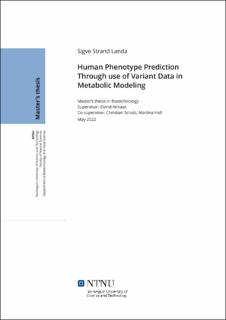| dc.description.abstract | Føremålet med dette prosjektet var utvikling av ein metode for bruk av variasjonsdata til å selektere gen for fjerning i metabolsk modellering. Motivasjonen er moglegheita til å kunne oppdage sjukdomsframkallande variantar, samtidig som at mekanismane for sjukdommen kan bli beskrive. Variasjonsdata frå 2548 individ frå 1000 genom prosjektet, samt PheWAS data blei brukt i seleksjonen. Hovudfokuset var på SNPs, og spesielt ikkjesynonyme SNPs som produserer premature stop-kodon. Dette grunna deira meir destruktive natur, som vidare gir breiare grunnlag for fjerning av genet. For individ variantane ga dette 2600 SNPs som blei brukt til å produsere gen kombinasjonar for fjerning, basert på SNP kombinasjonane i individa. Ei rekke organ-spesifikke modellar basert på Human1 modellen blei brukt til FBA analyse. Spesifikke metabolske funksjonar blei testa gjennom bruk av konkrete oppgåver. Disse oppgåvene viste seg å vere svært nyttige i å avdekke problem forårsaka av manglande gen, med mange resultat som ikkje ville ha blitt oppdaga utan. I sum var metoden i ei rekke tilfelle vellykka i å reprodusera effekten av ein SNP, basert på allereie observert sjukdom. | |
| dc.description.abstract | In this project, a method was developed with the purpose of using variant data, primarily SNPs, to perform knockout metabolic modeling, in an attempt to predict diseases caused by the SNPs in question. This approach would not only allow detection of disease-causing SNPs, but also describing the mechanism behind a given disease. The data used was from 2548 individuals from the 1000 Genomes Project, as well as PheWAS data. Combinations of genes for knockout were generated based on SNPs present in the individual, and for PheWAS, SNPs associated with each other. There was a primary focus on nonsense SNPs as they are more likely to cause loss of function. For the individual data, some 2600 such SNPs were identified. These combinations then formed the basis for which genes would be knocked out when performing flux balance analysis (FBA). A number of Human1 based tissue specific models were used for the analysis. Additionally, metabolic tasks were used to further analyze the effects of the knockouts. The purpose of these tasks is to test specific biological functions within the models, and they proved instrumental in detecting issues caused by the knockouts, including many that would have otherwise gone unnoticed. To conclude, for several cases, the approach was successful in predicting disease, with the results matching what was expected based on existing literature. | |
